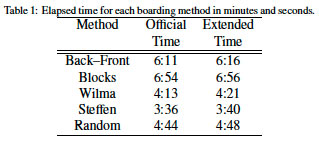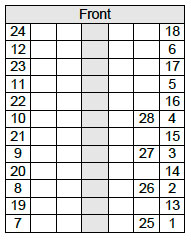It’s not rocket science, but it apparently took an astrophysicist to figure it out: boarding an airline in blocks (i.e. group A, then group B) is slower than boarding at random, which is slower than boarding by alternating rows:
The Ste ffen method has the passengers lining up in a prescribed order. This order incorporates in a specific way boarding from the back to the front and from the windows to the aisle. Adjacent passengers in line are sitting two rows apart from each other in corresponding seats (e.g. 12F, 10F, 8F, 6F, 4F, 2F). This method attepts to eliminate seat interferences and, as much as possible, aisle interferences while naturally allowing multiple passengers to stow their luggage simultaneously. The separation between adjacent passengers provides some space for each passenger to manipulate their luggage into the bins.
If you think about it, it makes sense. When boarding a plane, the delays usually result from everyone in the same section of the plane trying to put all their stuff in the overhead bins, and from people in aisle/center rows sitting down before the person in the window seat. By maximizing the space between boarding passengers, it makes those tasks faster or non-existent. And the authors, Fermilab astrophysicist Jason Steffen and TV producer Jon Hotchkiss, found considerable time savings in their study, "Experimental test of airplane boarding methods":

(The "Wilma" method seats window-seat passengers first.)
Here’s a diagram of how it works:

And a video:
Via many places. As Steffen writes:
I was quite surprised about the media attention that this work received. Indeed, it was interesting to see the gestation period between posting the first paper on the arXiv and watching it appear on blogs and in other media outlets. It started on Cosmic Variance (thanks Julianne), and within a few hours appeared on a Cornell University economics class blog talking about Braess’ Paradox (I think it was an econ class, I can’t find the post any more). My first phone call from a reporter was at about day four. Interest peaked between days 10 and 14 with articles having appeared on physorg.com, wired.com, New Scientist, Nature news, Slashdot, a bunch of news websites (CNN, ABC, etc.) and both foreign (from Germany to Korea) and domestic newspapers (including my hometown Davis County Clipper). My first radio interview was with the BBC which spread to NPR (see below), a Canadian news agency, and some radio shows in Ireland and Australia—there were others, I should have kept better records but unfortunately didn’t. Another interesting thing was how I became a nuclear physicist, an atomic physicist, and a rocket scientist as the reporting went to second and third-hand sources. I’m sure someone has done a study on how news stories evolve during their lifetimes, it was interesting to watch it happen in real-time.


